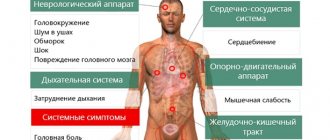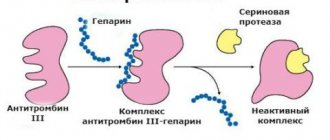The mucous membrane in the human body is a protective barrier. It protects internal organs and anatomical parts from infection or damage. The hyperemic mucosa loses its functions and cannot perform them normally.
Various factors can be provoking factors. It is necessary to go to the hospital to identify the main cause of this inflammatory process. Proper medical care will prevent possible complications.
Where in the human body are there mucous membranes?
The internal organs and systems of the human body are covered with a mucous membrane. Depending on its location, it performs certain functions. The main task of the mucous membrane is to protect organs from the penetration of pathogenic bacteria, thanks to the mucus produced.
The organs of the respiratory, genitourinary and digestive systems are covered with mucous epithelium. The same goes for the eyes, ear canals, nose and mouth. The mucous membrane has secretory cells that produce protective mucus.
Chronic form of inflammation
The consequence of a constant runny nose is chronic hyperemia. It can develop both with ordinary rhinitis and with prolonged sinusitis; their causes are bacteria, viral infections and fungi. Treatment is selected depending on the form of the disease. Reactive hyperemia occurs in cases of chemical damage to the skin, when drug-induced rhinitis is present.
One of the main reasons is the overuse of medications based on decongestants (the fastest-acting nasal decongestants). Their action is to relieve swelling of the mucous membrane by constricting blood vessels. Many people forget or simply ignore the fact that drugs of this type can be used for no more than 7 days, because later the body gets used to it, and the medicine simply does not work, as a result of which reactive hyperemia develops.
For inflammation of the nasal mucosa, complex therapy is prescribed. This may include:
- antibiotics;
- antiviral drugs that can fight microorganisms that cause the disease.
Local treatment methods include washing and moisturizing the mucous membrane; for this purpose, products based on sea salt and essential oils are used.
As additional measures, the otolaryngologist may prescribe physiotherapeutic procedures:
- electrophoresis;
- darsonval;
- inhalation;
- Ultrasound effect on parts of the nose.
All these methods allow you to relieve swelling, eliminate inflammation, and also normalize microcirculation and regeneration of the nasal mucosa.
Functions of mucosal membranes
Mucous epithelium is found in all internal organs and systems of the human body.
It performs the following functions:
| Name | Description |
| Protective | The mucous layer protects the lower tissues from the negative effects of internal and external factors. The same applies to infectious agents, bacteria, pathogenic factors. |
| Sensory | The mucous membrane has temperature, pain and tactile receptors. Their irritation activates certain reflexes. |
| Secretory | The secreted mucus removes pathogenic flora from the surface of the epithelium and protects it from mechanical damage, for example, when swallowing solid food. The mucus also contains antimicrobial substances that prevent bacteria and viruses from accumulating on the surface of the shell. |
| Immune | Saliva in the mouth contains antibodies that are necessary in the fight against pathogenic microorganisms. |
| Suction | In some places (oral cavity) the mucous membrane has a thin layer, due to which medicinal components are quickly absorbed and enter the blood. |
The mucous membrane also performs a thermoregulatory function in the human body, but it is not as important as other duties.
Atrophy of the nasal mucosa
Atrophy of the nasal mucosa is a chronic process, which in medicine is called atrophic rhinitis.
Doctors and scientists still cannot accurately explain this phenomenon, however, it is believed that atrophy can be provoked by frequent diseases of the nasopharynx, living in an environmentally unfavorable area, infectious diseases, working in hazardous industries, and complications after surgery.
The patient feels constant dryness in the nose, crusts regularly form in the nasal canals, and sometimes bleeding can be observed, which usually stops on its own. Atrophy, as a rule, is observed throughout the nasal cavity, and the patient partially or completely loses his sense of smell.
The video in this article raises the important issue of persistent nasal congestion.
What do moist integuments look like under normal conditions and with hyperemia?
The mucous membrane is a specific part of the human body's immune system.
Sufficient moisture allows the epithelium to perform its protective functions. A dry mucous membrane is more susceptible to external negative factors and easily allows pathogenic microorganisms to pass through.
Classification of inflammation
In some situations, inflammation of the mucous membrane goes away on its own, but under the constant influence of a provoking factor, pathological processes continue to develop and worsen the person’s condition.
In medicine, the following types of mucosal inflammation are distinguished:
| Name | Description |
| Acute | The inflammatory process quickly passes, after which the mucous epithelium recovers on its own. |
| Chronic | Appears as a result of untreated acute inflammation. Pathological changes affect the structure of the mucous membrane. It swells, thickens, and changes color. In some situations, atrophy or hypertrophy of the mucous membrane develops. |
In medicine, inflammation of various mucous membranes of the human body is called catarrh (catarrhal inflammation). The pathological condition is accompanied by the release of characteristic exudate.
Considering the composition of the secretions, the following classification of the inflammatory process is distinguished:
| Name | Description |
| Slimy | Desquamation and atrophy of the epithelium occurs, against which desquamative inflammation develops. |
| Serous | Pathological changes are accompanied by the release of cloudy exudate. |
| Purulent | The inflammatory process provokes the release of a purulent, turbid mass of gray-yellow color. The surface of the mucous epithelium is destroyed, erosive foci are formed, and hemorrhage appears. |
| Fibrous | Removal of pathological exudate leads to damage to the deep layers of the mucous membrane. |
| Hemorrhagic | The accumulation of a large number of red blood cells resembles a hemorrhage. |
There is a mucopurulent and blenorrheal type of catarrhal inflammation, when the upper layer of the mucous membrane is destroyed.
When does this happen?
Rhinitis occurs in three stages and in each of them there is an increased level of blood supply to the nasal vessels. At the first stage of disease development, the following is observed:
- severe dryness in the nasopharynx;
- tickling;
- irritation;
- deterioration of smell and nasal breathing;
- swelling of the nasal turbinates is hyperemia of the mucous membrane.
At the second stage, hyperemia remains as pronounced, but becomes more painful. Due to the fact that a serous secretion begins to be released from the nose, the mucus contains specific substances that irritate the external and internal membranes of the respiratory organ, not only redness, but also cracks appear.
In conditions of difficulty breathing through the nose or in its complete absence, lacrimation appears, which in turn can provoke a bacterial complication.
Hyperemia of the blood vessels of the nasal passages decreases at the end of the disease, namely when the secreted secretion acquires a greenish tint due to the death of bacteria. Nasal breathing improves, swelling also subsides.
Causes in adults, children
Hyperemia of the mucous membranes (catarrh) in children and adults occurs as a result of various reasons. In this case, characteristic clinical signs appear, with which it is important to contact the hospital in a timely manner.
Causes of catarrhal inflammation and hyperemia of the mucous membrane:
| Name | Description |
| Children |
|
| Adults |
|
In old age, the mucous membranes of old people become inflamed, since over time the epithelium wears out and its functional abilities decrease.
There are also numerous provoking factors that contribute to the development of pathological processes:
- allergic reaction;
Tests for allergens in adults are carried out when the causative agent is unknown - treatment with certain medications;
- weakness of the immune system;
- untimely treatment of certain diseases;
- unfavorable environmental conditions.
Genetic predisposition and autoimmune processes also contribute to damage to the mucous layer, even if there is no damage or disease to the epithelium.
Throat hyperemia: features of the disease, treatment
Additional education:
"Emergency Cardiology"
1990 – Ryazan Medical Institute named after Academician I.P. Pavlova
Contacts
Throat hyperemia is a common phenomenon. It occurs not only against the background of a cold, but also under the influence of various irritating factors. In some people, the mucous membranes of the throat change color under the influence of dyes or certain drinks, while in others this may result in an allergic reaction. Next, we will talk about what can cause hyperemia and how to deal with it.
Why does the pharynx change color?
In normal condition, the color of the mucous membranes of the mouth and throat is light pink. Redness in the pharynx appears under the influence of various factors. The color of the mucous membrane may be slightly red or have a rich scarlet tint.
In the latter case, people often think that they are seriously ill. In reality, this is not at all the case. A red tint to the mucous membranes of the throat can occur under the influence of a person’s lifestyle, i.e. if he has certain eating and other habits.
The main reasons for changes in the color of the throat mucosa are as follows:
- Biological effects. Viruses, microbes, bacteria cause inflammation. As a result, the color of the mucous membrane changes from pink to bright red.
- Physical impact. Reading speeches from the podium in a loud voice, prolonged coughing or screaming can cause discoloration of the lining of the mouth and throat.
- Exposure to low or high temperatures. Hot soup or ice-cold lemonade can be strong irritants. The vessels will react to them in the same way, i.e. expand for increased blood flow.
- Mechanical impact. Rough food or candy can act as irritants.
- Exposure to chemicals. Tobacco smoke, paint fumes and pollen enter the throat through the nose. They cause varying degrees of reaction. Someone may develop allergies as a result of their exposure.
As you can see, the mucous membranes can become hyperemic under the influence of various factors.
And most often this is not the influence of any chronic disease, but simply a person’s inattention to their eating habits.
Also, in some people, the inner linings of the throat may become stained due to chemical and natural dyes found in food. There's nothing wrong with that either.
Chronic diseases and hyperemia of the laryngeal mucosa
When the inner linings of the throat are hyperemic, this is most often due to the fact that a person has caught a cold. ARVI, acute respiratory infections cause inflammation, which goes away after the body copes with pathogenic bacteria.
But many people experience this phenomenon without having had any of these diseases. In such situations, you should go to an otolaryngologist, because... One of the reasons for this condition may be chronic infection.
To understand exactly where the source of inflammation is located, the doctor must examine the throat. For chronic infections, the doctor will see the following:
- slightly enlarged tonsils with a loose surface, indicating chronic tonsillitis;
- A bright red back of the throat and protruding lymph follicles are a sign of chronic pharyngitis.
People suffering from a constant runny nose also often experience hyperemia. Here, damage to the mucous membrane is caused by improper breathing and mechanical stress. Patients periodically clean their nose with some effort.
In addition, some people, when taking a horizontal position, block one of the nostrils. As a result, they begin to breathe through their mouth. Air masses entering the lungs in this way dry out the mucous membrane of the throat, which is not adapted to such loads.
As a result, it acquires a bright red color.
Before you start treating your own larynx, consult your doctor. It is likely that the reason for the change in color of its shells lies in your habits, and not in a cold. Be sure to check your digestive organs. Constant belching of gastric juice leads to minor burns, which can affect the color of the mucous membrane.
Methods for treating redness of the throat mucosa
The first place in the treatment of this phenomenon is to determine its cause. If you have a chronic runny nose, a treatment plan will be developed to normalize nose function.
If the cause is digestive problems, the patient will be sent to check the relevant organs. In case of venous hyperemia, surgery may be required, because
blood flow is obstructed in one specific place.
Objective symptoms
Inflammation of the mucous membrane is accompanied by general clinical symptoms:
- the affected area of the epithelium becomes red;
- soft tissues swell;
- local or general temperature rises;
- exudate is released from the affected mucous membrane;
- general weakness appears in the body.
When the mucous membrane of the respiratory system is damaged, a person experiences severe shortness of breath and cough with sputum. The respiratory process is also disrupted. If the inflammatory process begins on the mucous membrane of the digestive system, a person’s stool is disrupted, diarrhea or constipation, nausea appear, and dehydration occurs due to intoxication.
Restoration of nasal mucous membranes
In the case when the mucous membrane is hyperemic or has been subjected to thermal or mechanical damage, it must be restored. This procedure is carried out using antiseptic drugs, thanks to which the regeneration of damaged tissue occurs.
Natural remedies that quickly heal lesions are also widely used for this purpose. Thus, propolis is considered a harmless and effective remedy; it has a powerful nutritional, biostimulating and antibacterial effect.
This beekeeping product can be purchased both in its pure form in specialized stores and in pharmacies in the form of ready-made ointments and creams. Meanwhile, doctors recommend preparing your own medicine based on propolis, if possible.
- To prepare the medicine you will need 100 grams of crushed propolis and one liter of milk.
- The milk is heated until hot, propolis is added to it and the mixture is thoroughly mixed for ten minutes using a wooden spoon.
- Next, the mixture is filtered to separate the wax and cooled.
- The medicine is taken three times a day, one tablespoon one hour after meals. Store the solution in the refrigerator, but warm it slightly before use.
This remedy helps restore mucous membranes in cases of sore throat, burns and pharyngitis. To moisturize, heal and soften the nasal mucous membranes, this medicine can be instilled into the nose. Additionally, the solution can be used to heal the intestinal mucosa; in this case, a small medical enema is used.
Effectively treats and restores the mucous membrane with alcohol tincture of propolis for a runny nose.
- To prepare the tincture, you need 100 grams of crushed propolis and half a liter of medical alcohol.
- Propolis is poured with alcohol and infused for two weeks in a dark, cool place. The container with the tincture should be shaken periodically to prevent sediment from forming.
- After two weeks, the tincture is filtered and poured into a bottle with dark glass.
To rinse the nasopharynx, add 1 ml of tincture to 6 ml of boiled water.
Propolis ointment quickly heals lesions on the mucous membrane. Sea buckthorn oil, which can be bought at a pharmacy, has a similar effect.
This product can be used not only for internal rinsing; in addition, it can be used to lubricate the nasal passages.
Diseases due to hyperemia
Hyperemic mucosa is the first symptom that a certain disease is developing in the human body. You need to consult a therapist or pediatrician.
The specialist will conduct an examination, interview, and additionally prescribe a comprehensive examination and treatment based on the results obtained. Considering the source of the inflammatory process, the patient may need to consult other specialized doctors (dentist, gynecologist, otolaryngologist, gastroenterologist).
Diseases that provoke hyperemia of the mucous membrane:
| Damage area | Diseases |
| Stomach, esophagus |
|
| Oral cavity, throat |
|
| Nose |
|
You should go to the hospital if a person has a high body temperature and, after a slight improvement, the condition worsens further. Your doctor will help you establish an accurate diagnosis through a comprehensive examination. Timely therapy will prevent the occurrence of possible complications.
Symptoms
In addition to swelling and redness of the nasal mucosa, other symptoms are almost always present with hyperemia. It is always determined by the underlying disease. Adults may experience the following complaints:
- burning, itching in the nose;
- increased body temperature;
- nasal congestion;
- lacrimation;
- pain when swallowing;
- sore throat;
- headache;
- the appearance of mucous, serous or purulent discharge from the nose.
In children, hyperemia of the nasal mucosa is manifested by the following symptoms: frequent regurgitation, deterioration of sleep, intense gas formation, and convulsions. This condition is especially difficult for children under one year of age who do not yet know how to breathe through their mouths.
Diagnostic methods
A comprehensive examination is prescribed taking into account the patient’s complaints and the results of the patient’s examination. The following examination methods are used for diagnosis:
| Name | Description |
| Bacterioscopy | A diagnostic method that allows you to determine the causative agent of the inflammatory process. |
| General blood analysis | The research results show the general condition of the human body. Blood counts change, anemia and leukocytosis are detected, and the erythrocyte sedimentation rate (ESR) increases. |
| Radiography | An examination method with which the doctor determines the location of the inflammatory process, its size and the affected area. |
| Gastroscopy | Diagnosis is prescribed for damage to the mucous membrane of the digestive system. The procedure allows you to identify the source of inflammation, take tissue for research, and assess the general condition of the mucous epithelium. |
In severe situations, bacterial culture is prescribed. A diagnostic method that allows you to determine the causative agents of mucosal hyperemia and their sensitivity to antibacterial drugs. It is important to differentiate the disease against which the disorders appeared, since many pathologies are accompanied by similar clinical symptoms.
Redness of the throat in children
Let's consider the main ENT diseases with hyperemia of the pharynx, characteristic of children:
- Sore throat with scarlet fever. It manifests itself as intense redness of the throat along with the tonsils, the so-called burning pharynx. Hyperemia affects the posterior wall of the pharynx, palate, uvula and arches. Visually, a white coating is detected in the tongue area, but after a few days it becomes bright crimson in color. The rash is characterized by a descending nature, the rash increases in the area of skin folds. Then the skin becomes dry, and detachment occurs in the area of the palms and soles.
- Sore throat with infectious mononucleosis. A disease of viral etiology. A distinctive feature of the disease is that in addition to intoxication and catarrhal symptoms, upon examination, patients are noted to have enlarged and painful lymph nodes, liver and spleen.
- Sore throat with measles. It occurs against the background of an infectious disease with a high level of infection and mainly occurs in childhood. The disease is caused by a virus that itself is unstable in the external environment. Characteristic symptoms of general intoxication include a runny nose and a barking cough of a painful nature. At the same time, the patient's eyelids are swollen, the conjunctiva is hyperemic, and some patients experience photophobia. During the examination, against the hyperemic background of the oropharynx, granularity is visualized along the posterior wall. A distinctive sign of the disease is the appearance in patients on the fifth day in the area of the cheek mucosa, next to the molars, of whitish spots surrounded by a ring of hyperemia. On the seventh day, maculopapular rashes appear. When a rash forms, all of the above symptoms worsen. During the period of resolution, the elements of the rash fade away in the same sequence in which they appeared. Since specific treatment against the causative agent of measles has not been developed, only symptomatic therapy is currently used. It is important to carry out preventive measures between the ages of one and six years through vaccination.
- Sore throat due to diphtheria. It occurs against the background of a disease that mainly manifests itself in childhood. Diphtheria can affect many organs (oropharynx, larynx, nose, eyes). Diphtheria of the oropharynx is characterized by an acute onset, hyperthermia. Pain in the throat appears during swallowing, which is associated with changes in the oral cavity: the pharynx is slightly hyperemic, the soft palate and tonsils are swollen. A plaque in the form of a cobweb-like grayish film is visualized on the surface of the tonsils; when it is removed, bleeding of the mucous membrane is noted; over time, a new film is formed. This clinical manifestation is characteristic only of diphtheria, which makes it easy to differentiate. But, despite this, to confirm the diagnosis it is necessary to conduct a bacteriological examination. All patients with diphtheria should be hospitalized. The goal of therapy is to administer serum to a sick child, usually no later than the fourth day from the onset of the disease.
Although these diseases do not occur very often in children, they require detailed and timely diagnosis to avoid the development of serious complications.
What does the result mean?
A comprehensive diagnosis and the results obtained are necessary for the attending physician to determine the cause of inflammation and create the most correct treatment regimen.
Considering the results obtained, there are the following degrees of development of catarrhal inflammation:
| Name | Description |
| Moderately hyperemic mucosa | Inflammation provokes swelling of the epithelium and the formation of foamy plaque on the top layer. Uneven damage to the mucous membrane occurs. This is a mild form of inflammation. |
| The mucous membrane is focally hyperemic | The inflammatory process develops on a separate part of the mucous epithelium. |
| Diffusely hyperemic mucosa | Pathological processes affect all layers of the mucous membrane. |
An incorrect diagnosis will lead to the progression of pathological processes, which increases the risk of serious complications.
What is hyperemia
: 353
Every person at least once in his life has encountered redness of the skin of various parts of the body. This condition is called hyperemia. It is not classified as an independent disease, but is considered as a concomitant symptom of a number of pathologies.
What it is
Experts define the term hyperemia as a rush of blood to tissues as a result of the influence of the external environment. One of the clear examples of plethora is redness of the facial skin at high temperatures.
Hypertensive patients are also familiar with the condition of facial redness, which indicates the need to take medications to regulate blood pressure. Allergies, burns, and excessive physical activity manifest themselves in hyperemia from the first minutes. Some time after taking medications, the condition returns to normal. When redness is explained by pathology, the healing time increases.
Kinds
Hyperemia is divided into such types as physiological and pathological, acute and chronic, local and general, arterial and venous.
Arterial
Congestion caused by a rush of arterial blood is called arterial hyperemia. There are several reasons for its occurrence, all of them are accompanied by an increase in blood flow in the tissues.
Manifestation of arterial hyperemia
This type includes natural (physiological) skin hyperemia and various types of pathological:
- inflammatory, the symptoms of which are an increase in the lumen of blood vessels and a rush of blood in a separate area (accompanied by mild swelling and high temperature);
- after anemia, due to impaired blood flow, when after recovery the blood suddenly fills the vessels;
- hyperemia due to arteriovenous shunt, when excess blood enters the artery from a vein;
- redistribution (vacate) hyperemia, for example, in divers’ decompression sickness;
- compensatory (collateral), when blood flow through large vessels increases.
Venous
Venous hyperemia of the skin is also called passive, since it appears as a consequence of certain body conditions: heart failure, narrowing of the lumen of large vessels, uncomfortable body position for a long time. With this type of plethora, a decrease in temperature in the affected area is observed.
Other types
Other types of hyperemia on the skin are intense:
- medicinal – when medications cause obvious hyperemia,
- toxic;
- reactive – temporary in response to a stimulus;
- reflex – reaction in response to an external stimulus;
- working – when the function of some organ, and sometimes the whole organism, is enhanced;
- artificial - called specifically for the purpose of recovery;
- after an ischemic attack - when blood flow is restored;
- hypostatic accompanies heart failure.
View of the limbs with venous hyperemia
On the face
Facial hyperemia is observed with increased emotionality. It is typical for modest people and cannot be treated as an independent disease.
Experts advise treating the nervous system to rule out neurocirculatory dystonia. There is no complete cure, since strong emotions, including negative ones, are difficult for a person to control.
On the skin
Skin hyperemia occurs during allergies and is acute. It begins with the skin of the face and spreads to the entire body, turning into pathological plethora.
In addition to natural hyperemia, all types indicate pathological processes in the body.
Skin hyperemia can be caused by:
- lupus erythematosus, in which redness of the facial skin appears in a butterfly pattern from the nose to the cheeks;
- otolaryngological diseases - rhinitis, for example, causes redness of the nasal mucosa and the skin around it;
- increased hemoglobin causes slight redness of the skin;
- a sharp change in temperature during overheating and undercooling;
- physical impact on the skin (abrasions);
- allergic manifestations;
- gastrointestinal diseases;
- increased body temperature due to infectious diseases;
- high pressure;
- menopausal manifestations of hyperemia during “hot flashes”;
- inflammation of the skin as a result of injury to an area of the body.
Foci of skin hyperemia can be located remotely, for example, with atherosclerosis or diabetes, the skin of the foot initially turns pale and then turns red. Venous hyperemia is expressed by bluish skin on the sole.
In addition to the plethora of the skin and mucous membranes, hyperemia of the internal organs is observed. This phenomenon is especially typical for the lungs and is called brown induration. Occurs with mitral valve defects.
Mucous eyes
If the mucous membranes of the eyes are red, it is suggested, first of all, to work for a long time at the computer. Hyperemia of the eyes indicates the need for rest. But sometimes redness indicates the presence of a disease.
The causes of eye hyperemia are different:
- fatigue;
- injury;
- hemorrhages (with increased pressure or tension);
- inflammation of blood vessels, for example, conjunctivitis.
Trauma and hemorrhages do not raise any questions and their treatment is clear. But redness, especially accompanied by purulent discharge, requires careful examination. In this case, a prompt visit to an ophthalmologist contributes to a quick recovery.
Eye hyperemia due to conjunctivitis
On the throat
Hyperemia of the pharynx can indicate a number of diseases. Redness of the throat is a symptom of catarrhal or phlegmonous sore throat. A red throat along with a sore throat indicates a flu-like condition or pharyngitis.
By examining the pharynx, the doctor begins to diagnose severe infections:
- measles disease;
- tularemia;
- listerellosis;
- foot and mouth disease;
- Infectious mononucleosis;
- meningitis.
Hyperemia of the pharynx is a sign of diseases - acute leukemia, agranulocytosis in the blood.
In children
The child's body reacts much faster to negative external factors. The skin of babies is very delicate and with slight overheating a small rash immediately appears. Childhood diathesis is manifested by redness of the skin on the cheeks.
Hyperemia in a child can signal an infectious disease, for example, rubella, scarlet fever. The initial stage of viral diseases is also determined by redness of the facial skin, which indicates an increase in temperature.
It happens that during crying or nervous tension, a bright beauty of the skin appears, which also quickly disappears when the baby calms down. This is a manifestation of physiological hyperemia.
Doctors draw attention to the fact that the same manifestations of hyperemia in adults pass without consequences, but in children they are fraught with complications. Therefore, when the first signs of redness of the skin or mucous membranes appear, the child should be shown to a doctor.
Symptoms
The main symptoms of hyperemia can be considered:
- redness of an area of the body;
- skin spotting;
- unpleasant sensations similar to “burning”;
- increase in body temperature;
- increased blood flow.
Sometimes hyperemia occurs for a short time and only the patient or his close people notice it. Therefore, when you first notice symptoms of hyperemia, you need to consult a doctor.
Treatment
Hyperemia is not an independent disease and therefore cannot be treated separately. All therapy is aimed at treating the underlying cause. For example, an allergic reaction can be relieved with antihistamines.
Infections, depending on the etiology, are treated with antibiotics and anti-inflammatory drugs.
In case of emotional excitability, measures are developed that will strengthen the nervous system and reduce excitability.
Treatment of hyperemia is based on compliance with a number of measures:
- visiting a doctor;
- exclusion of the cause of hyperemia;
- rinsing the affected areas of the body with warm water;
- the use of medications that improve blood microcirculation;
- taking sedatives;
- for skin hyperemia, wiping the affected area with a special solution;
- for infections, antibiotics and antifungals are required;
- taking detoxification medications to cleanse the body;
- in case of severe itching, it is necessary to take antihistamines;
- in case of complications with cerebral edema, bed rest is observed;
- For special indications, massage is prescribed.
Prevention
Prevention of hyperemia comes down to simple measures:
- avoid hypothermia and overheating;
- strictly adhere to the treatment of diseases recommended by the doctor;
- wearing comfortable clothes and shoes;
- use of personal protective equipment;
- maintaining a healthy lifestyle;
- compliance with personal hygiene rules;
- eating easily digestible foods.
Source: //SostavKrovi.ru/sosudy/kapillyarov-ven-arteriy/chto-takoe-giperemiya.html
Treatment of hyperemia in adults, children
The mucous membrane is hyperemic - this means that you need to go to the hospital and be examined. Therapy for small and adult patients is drawn up taking into account the results obtained after a comprehensive diagnosis. Children are prescribed gentle medications, taking into account the area of the inflammatory process and the individual characteristics of the small organism.
| Group of drugs | Name | Application |
| Antibacterial agents | Augmentin, Amoxiclav | The adult dosage is 1 tablet (250-500 mg/125 mg) 3 times a day. The course of treatment lasts 5-14 days. |
| Antihistamines | Tavegil, Suprastin | The drug is taken orally in the morning and evening, 1 tablet. |
| Antiseptics | Cholisal, Furacilin | Medicines in the form of sprays or tinctures are used to treat the affected mucous membrane. Some products are applied topically 2-3 times a day. The medicine is applied to the affected area and rubbed in with light massaging movements. |
| Immunostimulating drugs | Immunal, Amiksin | The tablets are taken orally with a sufficient amount of water. The adult dosage is 1 tablet 3-4 times a day. The course of treatment lasts 1-8 weeks. |
| Antifungal | Daktarin, Miconazole | To rinse the mucous membrane, it is recommended for an adult patient to use 0.5 scoop 4 times a day. The cream is applied to the affected areas and rubbed in with light massage movements. The course of treatment lasts 7 days. |
| Antiviral agents | Acyclovir, Serol | The medicine is taken orally 200 mg 5 times a day. The course of treatment lasts 5 days. |
In addition to drug treatment, patients are advised to attend physiotherapeutic procedures after the exacerbation period has subsided. It is also recommended to take a course of vitamins to increase the body's defenses.
How to treat a throat?
Treatment of diseases is determined by the reasons that caused hyperemia.
If it is a sore throat, then you cannot do without the use of antibiotics.
Drug treatment of sore throat is carried out using antibiotics that have a wide spectrum of action. This could be: ampicillin, erythromycin and a number of others. However, hyperemia is not always associated with a viral infection. If it is a virus, then it cannot be treated with antibiotics. You should take medications that will help strengthen the immune system: cycloferon, oscillococcinum, viferon.
Do not forget that even colds can have complications. Sometimes even ordinary flu has complications on the heart and lungs. Sore throat is very insidious, it can lead to kidney problems.
A child's throat becomes red when he or she is oversaturated.
How to treat a red throat and whether it should be done if it does not.
If your throat hurts in the Adam's apple area, it may be painful to swallow.
Some people, hearing that their Adam’s apple hurts, often don’t even bother.
If you have a sore throat or a feeling of dryness, you don’t have to “fly” to the doctor. For the first 2-3 days, you need to vigorously gargle with an antiseptic, dissolve tablets, and exclude irritating foods and dishes from food. If after a couple of days your throat hurts and your temperature exceeds 37 degrees, it is better to see a doctor.
Neglecting such a symptom as a red throat can lead to chronic diseases.
Various sucking remedies effectively help with the throat. These can be tablets, lozenges, lozenges. Their advantages include targeted action on the source of pain. They have an antiseptic, anti-inflammatory, soothing, analgesic effect. It usually takes less than a minute for the tablet to start working. Among the popular resorption agents are the following:
- Falimint. It contains menthol, so after use it creates a cooling sensation. The drug does not dry out the mucous membrane, eliminates sore throat well, and relieves dry cough.
- Faringosept. Has a disinfectant and analgesic effect. It can be combined with sprays, rinses, and antibiotics.
- Grammidin. It copes well with pain, starting from the first use. The maximum course of treatment should not exceed a week.
- Strepsils. Quickly eliminates sore throat and pain. Not suitable for pregnant and lactating women. Exceeding the recommended dose may lead to nausea, vomiting, and diarrhea.
Doctors often have to answer the question: why does one remedy help immediately, while another turns out to be absolutely useless? The answer is simple: each medicine has its own “sphere” of activity, effective against certain microorganisms. Knowing these features helps you choose the right medications.
Rinsing
As soon as your throat starts to hurt, you need to start gargling. The solutions wash away the infection from the mucous membrane and have a calming effect. You can rinse the mucous membranes with ready-made and homemade remedies. Among the ready-made solutions, several can be distinguished:
- Iodinol. Add 15 ml of Iodinol to a glass of water, rinse your throat with the resulting solution, holding the liquid in your mouth for a few seconds. The drug has a pronounced antimicrobial effect and is inexpensive.
- Furacilin. The tablets are dissolved in water and used for rinsing. Furacilin even helps with sore throat.
A solution of soda and salt has an antiseptic effect. It can be quickly prepared at home by dissolving a spoonful of salt or soda in boiling water. The rinse liquid should be no more than degrees. Antiseptics eliminate the cause of pain - viruses, microbes; herbal infusions with sage, chamomile, and calendula will help remove inflammation.
Spray irrigation
A small can of spray or aerosol is convenient to carry with you and can be used anywhere. It contains a complex of substances that have antiseptic, anti-inflammatory, and analgesic effects. The effect after injection occurs almost instantly. Many drugs are available in the form of a spray and rinse solution. Each patient can choose a convenient option for himself. Popular sprays:
- Inhalipt. Contains essential oils, analgesic and anti-inflammatory components. It works more effectively in combination with other medications. The drug is cheap and easy to use. The duration of treatment should not exceed 5 days.
- Faringosprey. The frequency of use is up to 3 times a day, one dose includes two injections.
- Miramistin. A unique product that is effective against most microbes. With a doctor's permission, it can be used even by pregnant women.
A contraindication to the use of the spray, as well as other dosage forms, is individual intolerance to the components. Before use, you should carefully study the instructions.
- In the fight against swelling, it is better to use chamomile infusion or soda composition for daily rinsing.
- If the mucous membrane of the throat has small spots, and the patient has difficulty breathing, it’s time to suspect scarlet fever and promptly contact your local pediatrician (general practitioner).
- Gargling with a decoction of calendula, for example, softens the throat, but is not able to destroy pathogenic flora (if any).
The red mucous membrane of the throat is successfully treated with conservative methods and physiotherapeutic procedures. These are antiseptic sprays and bactericidal solutions, oral tablets, and lozenges dissolved under the tongue. Their therapeutic effect is local; penetration of active components into the systemic bloodstream is not observed. In such a clinical picture, it is appropriate to use several pharmacological groups at once, including:
- local antiseptics in the form of lozenges for resorption: Isla, Strepsils;
- disinfectants: Givalex, Rotokan, Trachisan;
- immunostimulants: Amiksin, Remantadine;
- local antibiotics: Bioparox, Stopangin;
- systemic antibiotics: Amoxiclav, Zinnat.
If we talk about the most effective medications for the conservative treatment of red larynx, it is recommended to highlight the following pharmacological positions:
- Amiksin. These are pills that can enhance the body's immune response. It is recommended to take 1 pill orally twice a day - morning and evening for the purpose of treatment, 1 pill - daily for effective prevention.
- Strepsils. These are effective and affordable oral tablets. It is recommended to take 3 – 5 pills per day until the alarming symptoms – redness, pain and soreness – completely disappear.
Pharyngitis is an inflammatory process of the pharyngeal mucosa of an acute or chronic nature. Pharyngitis is manifested by soreness, discomfort and pain in the throat.
It is customary to divide pharyngitis into types according to the localization of inflammation. The human pharynx has three sections - the nasopharynx (upper section), oropharynx (middle section) and hypopharynx (lower section). But such a division in most cases will be only conditional, because with the development of acute pharyngitis, diffuse damage to the mucous membrane occurs.
Folk remedies
Hyperemic mucosa is a pathological condition that can be treated using complex methods. Folk remedies can be used for symptomatic therapy, but strictly after consultation with a doctor, especially if a child is ill. Many of the components used provoke an allergic reaction or individual sensitivity.
Effective folk remedies:
| Name | Recipe | Application |
| Herbal collection | Mix marshmallow, fennel fruits, chamomile, and licorice root in equal parts. Grind all ingredients well and pour 1 tbsp. herbal mixture with hot water (1 tbsp.). Place over medium heat and continue heating for 15 minutes. Leave the resulting infusion for 3 hours, strain and take orally. | The recommended adult dosage is 0.5 tbsp. 2 times a day. |
| Milk with propolis | Pour 100 g of crushed propolis with hot milk (1 l). Mix all ingredients well. Strain the resulting mass and cool. | It is recommended to take the finished medicine 3 times a day, 1 tbsp. after eating 60 minutes. |
| Walnut leaves | Pour 5 g of leaves with hot water (250 ml). Leave overnight, strain well in the morning. Dilute the concentrated tincture (3 tablespoons) with warm boiled water (200 ml). | It is recommended to use the finished product for rinsing the mouth 3 times a day for 14 days. |
| Viburnum bark with zest | Pour hot water over the ingredients and leave for 30 minutes. It is recommended to take the finished product orally. | The adult dosage is 1 tbsp. every 3-4 hours. |
| Beans | Pour 30-40 g of the product with hot water (1 l). Leave for 40-60 minutes and strain. | The resulting product is recommended to be taken orally, 0.5 tbsp. 3 times a day. Bean infusion reduces inflammation and has a diuretic effect. |
Hydrogen peroxide will help eliminate severe pain. It is enough to mix 1 tsp. solution with water. The resulting product is recommended to be used to rinse the mouth 3-5 times a day.
Causes
Hyperemia itself is not a disease. Redness or swelling of the mucous membrane is a sign of a disease. Most often, hyperemia is observed during viral infections (ARVI).
In this case, it can spread to the mucous membrane of the throat, accompanied by sneezing, itching, increased body temperature, difficulty in nasal breathing, coughing, and mucous discharge.
With a bacterial etiology, white-yellow or green mucus may be released from the nasal passages (purulent, serous discharge). Other causes of hyperemia of the nasal mucosa:
- mechanical injuries;
- allergy;
- the effect of irritants (dust, aerosol, toxins);
- compression of blood vessels by neoplasms, adhesions, scars;
- acute or chronic rhinitis;
- adenoiditis, sinusitis, sinusitis, ethmoiditis and other inflammatory diseases.
Redness and swelling of the mucous membrane can also occur for physiological reasons. For example, from exposure to cold, hot water, etc.
Possible complications and prognosis
Inflammation of the mucous epithelium is not a serious and dangerous condition for humans. However, complications caused by pathological processes arise in the absence of timely and properly selected therapy.
| Name | Description |
| Meningitis | A complication that occurs due to inflammation of the nasal mucosa. The infection spreads to the brain structures. The lining of the brain becomes inflamed. |
| Malignant tumors | A long-term inflammatory process on the surface of the mucous membrane leads to degeneration of damaged tissues. Under the influence of negative factors, malignant processes develop and a tumor forms. |
| Sepsis | Chronic bacterial or viral inflammation of the mucous epithelium leads to the pathogens entering the blood. Secondary infection occurs. Pathogenic microorganisms spread throughout the human body through the blood or lymph. |
The quality of human life is also affected. The acute form of inflammation progresses to the chronic stage. There is a high probability of a purulent abscess or atrophy of the epithelium of the affected mucous membrane. In some situations, complications require surgery.
Hyperemic mucosa, depending on the area affected by the inflammatory process, provokes characteristic clinical symptoms.
It is impossible to determine the exact cause of the pathological condition on your own; it is important to contact a therapist and get advice. If necessary, the specialist will prescribe additional diagnostic tests to select the most effective treatment.
Drug-induced (reactive) rhinitis
Reactive hyperemia is a response to drug treatment for a runny nose. As a rule, it occurs against the background of long-term use of vasoconstrictor drugs. Drops, sprays based on naphazaline, tetrizoline, oxymetazoline, xylometazoline.
With drug-induced rhinitis, the normal movement of the vascular walls is disrupted, mucosal cells degenerate, cilia are lost, which complicates the process of cleansing the epithelium. In addition, patients have enlarged mucous glands, as a result, mucus secretion increases. Drug-induced rhinitis is difficult to treat.










